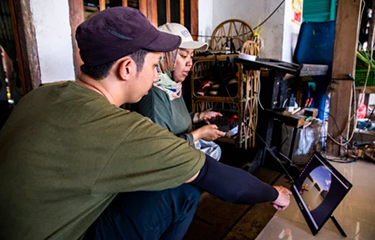Three crab landing sites in the province of Lampung in Sumatra, Indonesia, have implemented new technology to better monitor the activities of small-scale fisheries in the area.
The Environmental Defense Fund (EDF), with local partners in Indonesia and technological help from U.S. firms CVision AI, Teem Fish Monitoring, and Snap IT, developed a smart camera system in 2020 called SmartPass, an electronic monitoring approach focused on bridging the data gap in small-scale fisheries by combining camera systems with artificial intelligence (AI) to estimate total catch from vessel activity. In March 2023, EDF installed these smart cameras at each of the three major Lampung crab landing sites to monitor total crab catch and effort statistics.
According to the Food and Agriculture Organization (FAO), small-scale fisheries are responsible for 40 percent of global fisheries catch but often suffer from unassessed and unreported catch. Indonesia’s blue swimming crab fishery accounts for 23,000 metric tons (MT) of product with a value around USD 300 million (EUR 278 million) annually, but due to the small-scale nature of many Indonesian fisheries, it lacked monitoring capabilities.
“The blue swimming crab stock is currently in decline; monitoring fishery performance is critical for developing management measures that can reverse this trend and ensure vital benefits, such as food, income, and employment, far into the future,” EDF Oceans Technology Solutions Director Christopher Cusack told SeafoodSource. “Data collection activities can be performed more effectively and accurately with cutting-edge technologies, such as smartphone catch reporting and SmartPass effort estimation.”
Indonesia has an estimated two million fishers working around 17,000 islands. The country’s complex geography is a factor in rampant unmonitored fishing activity across the Indonesian archipelago. Indonesia’s small-scale fisheries use a variety of watercraft and reel in diverse catches, and often work in remote areas, inhibiting successful fisheries monitoring and management.
However, smartphones used in conjunction with the three cameras installed at the landing sites in Lampung – chosen because they provide clear cross-channel views in narrow sections of ports – have generated reliable estimates for the total effort and catch totals in the blue swimming crab fishery, according to EDF. SmartPass works through a cloud-based AI algorithm that counts vessels passing in and out of the port. Dock samplers or enumerators fill the second half of the needed information by conducting interviews with fishers returning from trips to record catch amounts and biological data. Averaging the number of fish caught per vessel and multiplying that by the number of vessel trips produces a total catch estimate.
“Utilizing these technologies helps bridge a significant data gap, enabling fishery managers to confidently address issues by both using a robust scientific platform and considering the community's needs,” Cusack said. “Reduced uncertainty enables fishery management that produces less risk of catastrophic stock collapse and a higher probability of growing and maintaining stocks, resulting in higher levels of community resilience to the growing impacts of climate change. Additionally, data can also be used to respond and adapt to changing seasonal conditions in fisheries.”
The local community in Lampung has become a willing partner in the project, and aids it by providing a source of power and a stable internet connection, according to Cusack.
“Initially, many fishers in the province were reluctant to participate in the data-collection process. They perceived it as an interruption to the post-production process without any direct benefit for them. Gradually, fishers began to see the benefits as they acclimated to the data collection initiative. Data sharing provides multiple benefits, allowing fishers to monitor catch trends and stock health indicators,” Cusack said. “As a result, many fishers became interested in learning about the status of their fishery stocks. Currently, fishers are open to data collection; some even take the initiative to reach out to the enumerator independently. Encouragingly, other fishers have expressed interest in collecting their own fisheries data.”
EDF aspires to deploy its SmartPass technology in small-scale fisheries globally to enable better fisheries management of stocks, improvement of local climate resilience and sustainability in coastal communities, and creation more stable livelihoods and food security for local communities.
“Our work in Lampung can be a model for other fisheries in Indonesia, Southeast Asia, and globally,” Cusack said. “A paradigm shift in how small-scale fisheries are managed – to one where good data is used to secure the future of healthy fisheries – is now feasible, thanks to the power of new and emerging technologies. Our work contributes to growing evidence that this shift is possible and that small-scale fisheries are not doomed to decline. They are far too important for too many people to continue undervaluing.”
According to the EDF, small-scale fisheries create as much food for human consumption as larger industrial fisheries. But they mainly operate around the tropics, where the impacts of climate change are being most severely felt.
“Fish populations in Indonesia and worldwide are subjected to compounding environmental stressors from high fishing pressure and climate change,” Cusack said. “Affordable and scalable solutions for improving data collection and the scientific understanding of the marine environment are crucial for enhancing the resilience of fish stocks and fishing communities that depend on them.”
Photo courtesy of EDF/Wahyu Mulyono







